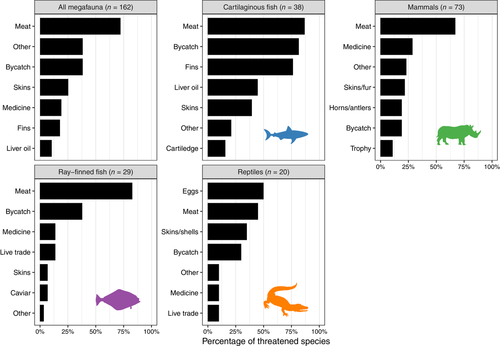Charisma
Humans Are Eating Large Animals to Extinction
Detailed data show size matters when humans choose to kill other animals.
Posted February 6, 2019
"Meat consumption was the most common motive for harvesting megafauna for all classes except reptiles where harvesting eggs was ranked on top." (William Ripple et al.)
I just learned of a new and incredibly important research paper by Dr. William Ripple and nine distinguished colleagues called "Are we eating the world's megafauna to extinction?" The title is clearly an attention-getter and I was singularly surprised, and in some cases shocked, by what these researchers discovered based on extremely detailed data analyses. The entire paper is available for free online, so here are a few facts to whet your appetite for more. (Supplemental data can be seen here.)

The researchers begin by defining megafauna "as vertebrate species that are unusually large compared with other species in the same class." Using this measure, megafauna refers to "all species ≥100 kg for mammals, ray‐finned fish, and cartilaginous fish, and all species ≥40 kg for amphibians, birds, and reptiles, because they have smaller body sizes, on average, compared with large mammals and fish." Based on these criteria, 362 extant species qualified as megafauna, and data show that these large species "are more threatened and have a relatively higher percentage of decreasing populations than all vertebrates together" and "the top‐ranked threat within each megafauna class was direct harvesting by humans, although there were typically multiple co‐occurring threats, mostly related to habitat degradation (Figure 2)." Notably, "Meat consumption was the most common motive for harvesting megafauna for all classes except reptiles where harvesting eggs was ranked on top (Above table, Figure 3 in the original essay; detailed supplemental data can be found here.)
Humans have evolved as "super predators"
"Megafauna are also of critical importance for conservation because the largest species are often flagship species, umbrella species, keystone, and engineer species or highly charismatic species..."
All in all, the researchers conclude, "we are in the process of eating the world's megafauna to extinction. Megafauna are heavily exploited for human consumption (Figure 3) and are, on average, 2.75 times more likely to be threatened by extinction than other vertebrate species that have been assessed by the IUCN [International Union for Conservation of Nature]...This means that seven out of 10 of our largest and most iconic fauna will experience further population declines in the near future, and three out of five could go extinct. Declines of the largest vertebrate species will jeopardize ecosystem services to humans and generate cascading evolutionary and ecological effects on other species and processes..." Basically, humans have evolved as "super predators" who are able to kill prey larger than themselves.
What truly caught my eyes is this statement: "The strong extinction bias toward species of large size is highly unusual and unmatched over the prior 65 million years (Smith et al., 2018). Humans, commonly using projectile weapons, differ from other predators of large prey, such as lions (Panthera leo) and wolves, in their ability to cause death at a distance (Worm, 2015). Attacking from a safe distance enables the tackling of very large, dangerous prey with much less risk to the predator, compared with the physical combat required for all non‐human predators on land and sea. In addition, the limitation of predator numbers through natural prey availability does not hold for humans, whose global population grows disproportionately to its sustainability because of our ability to produce food." (See the original essay for references.)
The researchers also write, "There is good reason to raise further awareness of the declining status of large vertebrates. Nine megafauna species went extinct or became extinct in the wild between the 1760s and 2012, and in each case this was due to excessive hunting or a combination of hunting and habitat degradation (Supporting Information Table S6). The reasons for hunting these species to extinction were for the acquisition of meat for consumption or for body parts such as skins, horns, organs, and antlers for traditional medicine or trophies (Supporting Information Table S6)."
It's not sensationalist hype to conclude humans are having serious negative impacts on countless nonhumans and diverse ecosystems
It's a huge understatement to say that all humans should be very concerned about what these researchers discovered. To this end, Dr. Ripple and his colleagues write, "The ecosystem impacts that the loss of megafauna may entail are likely out of proportion to their dwindling numbers and small collective biomass. The ongoing loss of megafauna alters the structure and function of their ecosystems, often in ways that are surprising and disruptive (Estes et al., 2011, 2016). Known examples include impacts on seed dispersal, nutrient cycling, fire, and small animals when large terrestrial herbivores decline (Ripple et al., 2015), or the destabilization of fish communities that experienced a loss of sharks and other large predators (Britten et al., 2014)."
We're also told, "In conclusion, our heightened abilities as hunters must be matched by a sober ability to consider, critique, and adjust our behaviors to avoid consuming the last of the Earth's megafauna..." I couldn't agree more.
The data speak for themselves, and clearly time is not on our side or on the side of the nonhumans in an increasingly human-dominated world. There's a lot of food for thought here for anthrozoologists and conservation psychologists. (Also see "Sentience and Conservation: Lessons from Southern Africa" and "'Just Preservation' Favors the Intrinsic Value of Animals.") I hope this essay receives a broad global readership, and that the conclusions these researchers draw will be taken very seriously. It's not sensationalistic hype to conclude humans negatively and severely influence the lives of countless nonhumans and their homes and that our behavior and our patterns of consumption have major impacts on diverse ecosystems all over the world. Surely we can and must do better not only for the other animals themselves, but also for ourselves and future generations who will inherit the messes we leave for them.


